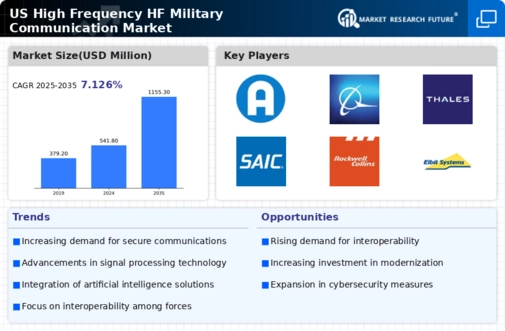Increased Military Spending
The high frequency-hf-military-communication market is experiencing a surge in demand due to increased military spending by the US government. In recent years, defense budgets have seen a consistent rise, with allocations for communication technologies being a significant focus. For instance, the US Department of Defense has earmarked approximately $700 billion for defense in 2025, with a notable portion directed towards enhancing communication capabilities. This trend indicates a robust commitment to modernizing military communication systems, thereby driving growth in the high frequency-hf-military-communication market. As military operations become more complex, the need for reliable and secure communication channels is paramount, further propelling investments in high frequency technologies.
Demand for Secure Communication
The high frequency-hf-military-communication market is propelled by the growing demand for secure communication channels within military operations. With the increasing prevalence of electronic warfare and interception threats, the need for encrypted and secure communication systems has never been more critical. The US military prioritizes the development of high frequency communication technologies that can withstand potential cyber threats and ensure the confidentiality of sensitive information. This focus on security is driving investments in advanced encryption methods and secure communication protocols, which are essential for maintaining operational integrity. Consequently, the market is expected to expand as military organizations seek to enhance their communication security measures.
Collaboration with Private Sector
The high frequency-hf-military-communication market is benefiting from increased collaboration between the military and private sector companies. This partnership fosters innovation and accelerates the development of cutting-edge communication technologies. The US military is actively engaging with defense contractors and technology firms to leverage their expertise in high frequency communication systems. Such collaborations are likely to result in the introduction of new products and solutions that meet the evolving needs of military operations. As the demand for advanced communication capabilities grows, this synergy between public and private sectors is expected to play a pivotal role in shaping the future of the high frequency-hf-military-communication market.
Integration of Advanced Technologies
The integration of advanced technologies into military communication systems is a key driver for the high frequency-hf-military-communication market. Innovations such as artificial intelligence (AI), machine learning, and software-defined radios are transforming traditional communication methods. These technologies enhance the efficiency and effectiveness of high frequency communication, allowing for better data transmission and improved signal clarity. The US military is increasingly adopting these technologies to ensure seamless communication across various platforms. As a result, the market is witnessing a shift towards more sophisticated communication solutions, which are expected to account for a substantial share of the overall market by 2026.
Emerging Threats and Geopolitical Tensions
The high frequency-hf-military-communication market is significantly influenced by emerging threats and geopolitical tensions. As global conflicts evolve, the US military is compelled to adapt its communication strategies to address new challenges. The rise of cyber warfare and asymmetric threats necessitates advanced communication systems that can operate effectively in contested environments. This has led to increased investments in high frequency communication technologies, which are essential for maintaining operational readiness. The US military's focus on enhancing situational awareness and real-time communication capabilities underscores the critical role of high frequency systems in modern warfare, thereby driving market growth.

















Leave a Comment